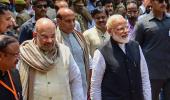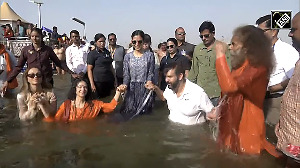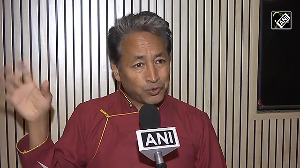The BJP is banking on development. The opposition is raking up caste identities and the dangers of hyper-nationalism.
But whoever wins, one thing is clear: Eastern UP is headed for a massive, grassroots transformation.
Aditi Phadnis reports from Gorakhpur.

No one is able to explain convincingly why a busy Gorakhpur hospital should be named the TimeNear Hospital. Maybe its owners have a sense of gallows humour.
But the name holds ominous portents: Not just for its patients but for the hospital itself. TimeNear will soon have rivals.
The only branch of the All India Institute of Medical Sciences in Uttar Pradesh -- in Gorakhpur -- is coming up at supersonic speed.
Its OPD services are already open. Construction contracts have been signed and work is on apace after the state government ruthlessly cut through all the land acquisition issues for the centrally funded project under discussion since 2012.
Growth points
Busy developing central UP and the Awadh region, former chief minister Akhilesh Yadav paid little attention to the eastern part of the state, which is arguably the most neglected, most backward pocket of Uttar Pradesh.
Gorakhpur and its adjoining areas -- Ghosi, Maharajgunj and Sant Kabir Nagar -- are best-known for Japanese encephalitis (brain fever), which used to routinely claim thousands of lives every year in the rainy season.
In 2017, more than 30 children in the state-run Baba Raghav Das Medical College died because the state government forgot to pay the dues of oxygen suppliers: And the chief minister was elected from Gorakhpur!
But the city is fast on the way to becoming the second capital of UP. State-of-the-art medical facilities will be available at minimal cost and infrastructure will rival that of Lucknow.
Gorakhpur got its first four-star hotel just two months ago, when the Radisson Blu was inaugurated.
"Gorakhpur has emerged as an important city from the point of governance," Raj Rana, chief executive officer, South Asia, Carlson Rezidor, told reporters when it opened.
Lotus Trans Travel Pvt Ltd has plans for a five-star hotel and international convention centre in Gorakhpur, investing Rs 135 crore.
There is talk of a Holiday Inn, even a JW Marriott Hotel opening in the city which is surrounded by Buddhist pilgrimage spots -- Srawasti, Kushinagar and, in neighbouring Nepal, just a few hour's drive, Lumbini.
Work has started on a four-lane road to link Gorakhpur with the Poorvanchal Expressway (Ghazipur to Lucknow).
Land acquisition in this part of the state is complicated and costly: Eastern UP has over 84 per cent of land holdings below one hectare (110,000 square feet) and agricultural fertility is high so negotiations with individual farmers can be protracted and extensive.
But lately, the number of small farmers turned crorepatis in the region is increasing.
Political changes
The fast pace of change has inevitably had its impact on politics in the area. For several decades, Gorakhpur -- and eastern UP generally -- has revelled in being the Opposition, luxuriating in its victimhood.
After prodigal son Vir Bahadur Singh became chief minister from the Congress in the 1980s and died young, eastern UP and Gorakhpur became peripheral to UP's development and political discourse.
But L K Advani's rath yatra and the demolition of the Babri Masjid propelled the Gorakhnath Math to centre stage in the politics of the region with first Mahant Avaidyanath and later his political heir, Adityanath, establishing their own suzerainty over the region -- with their own militia, systems and brand of justice.
When Yogi Adityanath became chief minister in 2017, quit his Lok Sabha seat of Gorakhpur, causing a by-election, and the Samajwadi Party candidate won the seat in 2018 (the Bahujan Samaj Party did not give a candidate), it was an unprecedented defeat, the first for the BJP in 27 years.
Adityanath has won five general elections in a row from Gorakhpur, the last three times with over 50 per cent of the vote. So how did this happen?
Many factors were at play. Bharatiya Janata Party president Amit Shah and UP unit president Mahendra Nath Pandey informed, rather than consulted, Adityanath about his replacement: Not a candidate from the Gorakhnath Math but a long-time BJP leader and Adityanath rival, Upendranath Shukla, a candidate of Union minister of state for finance, Shivpratap Shukla.
The way Adityanath supporters saw it, it was a move designed to cut the Math down to size. This in itself provides a clue about the nature of politics in this part of UP.
Role of caste
But there was another factor: The role of the opposition in mobilising the most important caste group in this area, the boatmen or Nishads.
All along the Ganga in UP, the Mallah and Nishad castes have extensive political clout. The community accounts for 14-17 per cent of UP's population and can influence 25-30 Lok Sabha seats.
For several years, these castes have run a campaign to be counted as Scheduled Caste. The government's decision to recognise them as such in 2016 is now facing a challenge in the Allahabad high court.
In 2014, the Nishads voted for Narendra Modi. In 2016, they formed their own party, the Nishad Party.
In 2018, they sided with the SP candidate, winning the Gorakhpur by-election, causing Yogi Adityanath to involuntarily exclaim it was an unprecedented defeat ('Apratyashit parajaya').
Now, a section of the Nishads has returned to the BJP. Some assurances and guarantees have reportedly changed hands and the winner of the by-election, Pravin Nishad, has jumped from the SP to the BJP.
He has promised his community's support to the BJP candidate, Bhojpuri film actor Ravi Kishan: Once again, not a nominee of the Math.
The SP has put up a rival Nishad: Ram Bhuwal Nishad, who has been a two-term fisheries minister in the state government.
The BJP is banking on development. The opposition is raking up caste identities and the dangers of hyper nationalism.
But whoever wins, one thing is clear: Eastern UP is headed for a massive, grassroots transformation.












 © 2025
© 2025